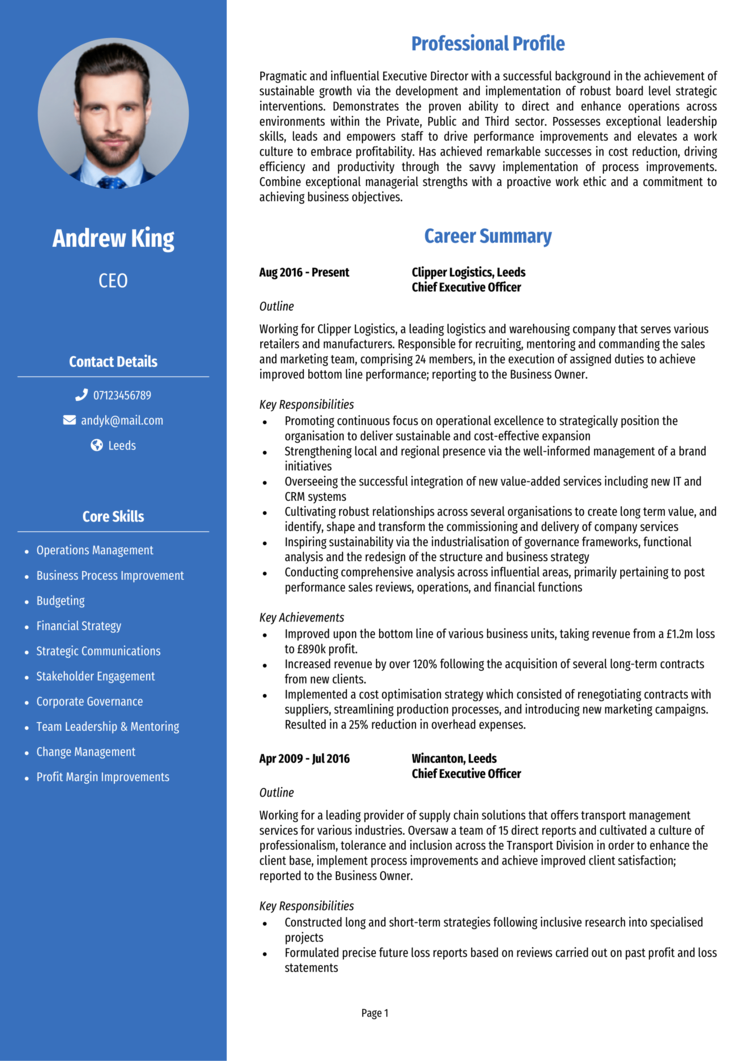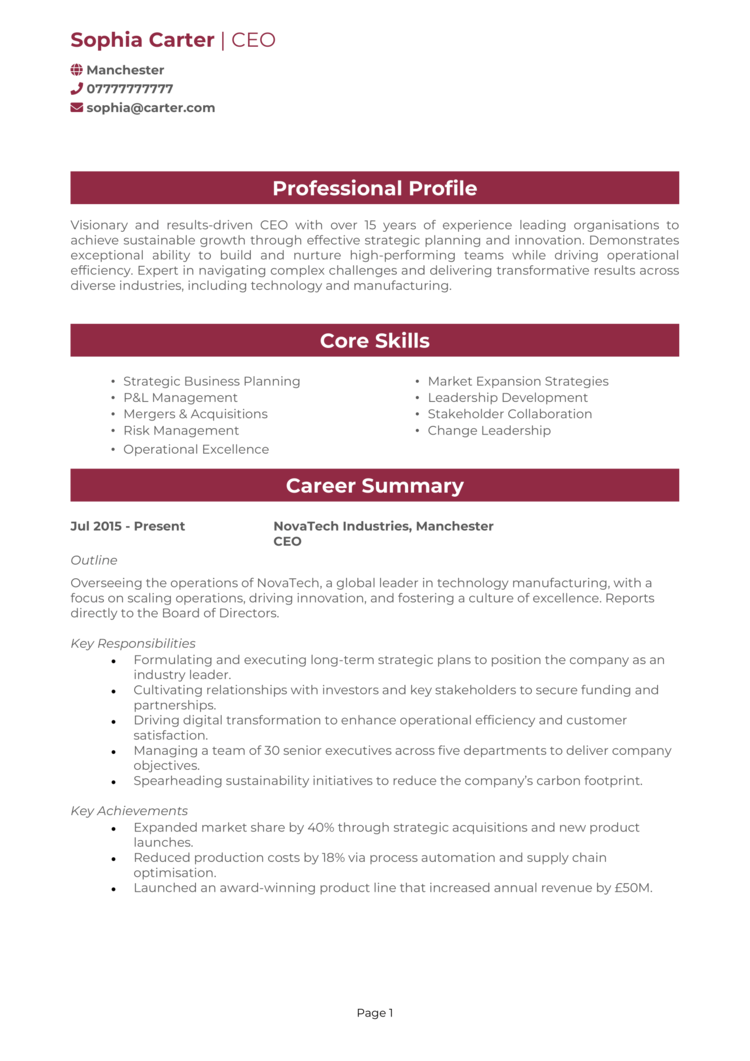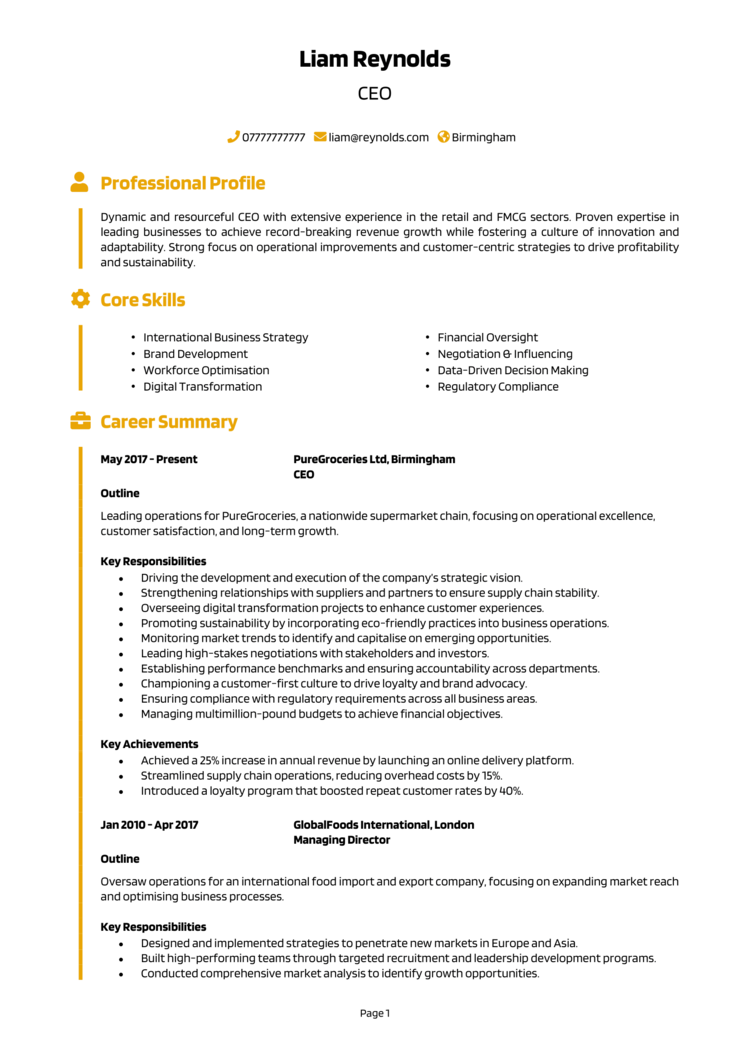Do you have the vision, leadership, and charisma to steer a company to success?
As a CEO, you’re not just at the top of the organisational chart – you’re responsible for charting the course. But before you can command the boardroom, you need to impress recruiters with a CV that demonstrates your achievements, leadership, and strategic impact.
This guide, complete with 3 CEO CV examples, will show you how to craft an application that commands attention and gets you into that corner office.
CEO CV example

Global CEO CV example

Strategic CEO CV example

How to write your CEO CV
Learn how to create your own interview-winning CEO CV with this simple step-by-step guide.
From structuring and formatting it to showcasing your leadership, strategy, and measurable results, this guide will give you everything you need to write a winning CEO CV and take your career to the next level.
CEO CV structure


Think of your CV as a corporate strategy document: structured, precise, and free from jargon that makes readers fall asleep. It needs to convey authority, leadership, and a proven track record, all in an organised layout.
Here’s how to structure your CEO CV:
- Name and contact details – Keep these personal details at the top so employers can reach you with ease. Including a photo is always optional.
- Profile – Hook the reader by summarising your leadership style, key achievements, and strategic vision.
- Core skills – Highlight your expertise in areas like corporate strategy, financial management, and team leadership.
- Work experience – List your roles in reverse chronological order, emphasising measurable impact and achievements.
- Education – Walk through your academic qualifications and executive training programs relevant to leadership roles.
- Additional info – Mention professional memberships, hobbies and interests, or philanthropic work that reflect your values and leadership ethos. This section is optional.
The best way to format your CEO CV


Your CV should reflect the professionalism and clarity you bring to the role of CEO. Remember, even the most accomplished leaders and impressive careers can falter if their CV doesn’t look the part. Don’t let formatting mistakes undermine your achievements.
Here’s how to format your CEO CV:
- Bullet points – These let the recruiter skim-read and pick out the key bits with ease.
- Divide sections – Use clear headings to guide the reader through your CV.
- Use a clean font – Just make sure your font is a clear one to read, with a consistent layout.
- Keep it the right length – Keep your CV no more than 2 pages long, providing enough space to showcase your skills and experience.
CEO CV profile


Your profile is your chance to make a powerful first impression. For a CEO, this is where you highlight your leadership accomplishments, strategic expertise, and vision for growth.
CEO CV profile examples
Profile 1
Strategic CEO with over 15 years of experience leading technology companies, driving revenue growth, and scaling operations. Skilled in developing corporate strategies, managing stakeholder relationships, and overseeing multimillion-pound budgets. Adept at leveraging market insights to identify opportunities for innovation and expansion.
Profile 2
Dedicated CEO with a decade of experience in the retail sector, specialising in business turnaround and profitability enhancement. Proven track record in implementing strategic initiatives, improving operational efficiency, and fostering collaborative work cultures. Skilled in leading cross-functional teams and managing investor relations.
Profile 3
Proficient CEO with 20 years of experience in the financial services industry, focusing on mergers, acquisitions, and international market expansion. Expertise in risk management, corporate governance, and building high-performing executive teams. Adept at navigating regulatory environments and fostering sustainable growth.
What to include in your CEO CV profile
Here are some tips on what to include in your CEO CV profile:
- Key results you’ve delivered – Mention achievements such as revenue growth, market expansion, or organisational transformation.
- Where you’ve worked – Mention the industries and companies you’ve led, focusing on those relevant to the role.
- Your top qualifications – Highlight degrees like an MBA or certifications in corporate governance.
- Essential skills – Include leadership qualities like strategic planning, stakeholder management, and growth optimisation.
- Company sizes you’ve worked with – Reference whether you’ve managed startups, SMEs, or global corporations.
What to include in the core skills section of your CV


Your core skills section is a snapshot of the leadership and expertise you bring to the table.
For a CEO, these might include corporate governance, operational efficiency, and stakeholder engagement. Tailor your core skills like you’d adapt a corporate strategy to a changing market – what’s critical for one role might not apply to another.
Key skills that make a CEO CV stand out
- Corporate Strategy Development – Crafting and executing long-term strategies to achieve organisational goals.
- Financial Management – Overseeing budgets, financial forecasts, and ensuring profitability.
- Stakeholder Engagement – Building relationships with investors, board members, and key partners.
- Operational Efficiency – Streamlining processes to enhance productivity and reduce costs.
- Market Expansion – Leading initiatives to enter new markets and grow market share.
- Team Leadership – Inspiring and managing multidisciplinary teams to achieve targets.
- Crisis Management – Navigating companies through economic downturns and unexpected challenges.
- Innovation Management – Driving technological adoption and fostering a culture of innovation.
- Change Management – Leading organisational restructuring and ensuring smooth transitions.
- Corporate Governance – Ensuring compliance with legal and ethical standards.
How to showcase your work experience in your CV


Your work experience section is where you prove you’re not just someone who talks the talk in the boardroom but someone who walks the walk (or at least takes decisive steps). Recruiters want to see how you’ve driven growth, managed crises, and delivered results.
List your roles in reverse chronological order, focusing on the outcomes of your decisions and strategies.
How to structure jobs

- Outline – Provide an overview of the company, your role, and the scale of the organisation.
- Responsibilities – Highlight key tasks like leading strategic planning, managing executive teams, or expanding market reach. Use action verbs like “orchestrated,” “led,” or “transformed.”
- Achievements – Showcase measurable outcomes, such as revenue increases, successful mergers, or market share growth. Always include numbers and figures wherever possible to make your impact clear.
Example jobs for CEO
CEO | InnovateTech Solutions
Outline
Led a technology startup from inception to a leading provider of SaaS solutions in the market. Focused on driving growth, fostering innovation, and building a strong organisational culture.
Responsibilities
- Developed and executed a five-year corporate strategy, aligning with market trends and customer needs.
- Managed relationships with investors, securing £10M in venture capital funding.
- Oversaw product development, ensuring alignment with customer demands and industry standards.
- Built and led an executive team, fostering a high-performance culture.
- Presented quarterly business updates to the board and key stakeholders.
Achievements
- Grew annual revenue from £2M to £20M within three years through strategic partnerships.
- Expanded into international markets, increasing customer base by 50%.
- Achieved a 95% employee retention rate by fostering a collaborative and innovative work environment.
CEO | Premier Retail Group
Outline
Directed the turnaround of a struggling retail chain, implementing operational improvements and customer-centric strategies. Focused on driving profitability and enhancing the brand’s market position.
Responsibilities
- Redesigned the business strategy to prioritise e-commerce and customer experience.
- Managed operational budgets, ensuring cost-effectiveness and resource optimisation.
- Collaborated with marketing teams to revitalise the brand image and attract new customers.
- Negotiated with key suppliers to improve profit margins and streamline supply chains.
- Established key performance indicators to monitor progress and guide decision-making.
Achievements
- Increased profitability by 30% within two years by implementing a lean operations model.
- Achieved 150% growth in e-commerce sales by launching a user-friendly online platform.
- Recognised as a Top 10 Retail Leader in the industry for transformative initiatives.
CEO | Global Financials
Outline
Led a multinational financial services firm, focusing on international expansion and regulatory compliance. Guided the company through complex mergers and acquisitions while driving sustainable growth.
Responsibilities
- Developed and implemented long-term business strategies to achieve corporate objectives.
- Oversaw M&A activities, ensuring seamless integration of acquired companies.
- Led risk management initiatives to navigate complex regulatory landscapes.
- Collaborated with the board to refine corporate governance and compliance frameworks.
- Engaged with global stakeholders to enhance the company’s reputation and market share.
Achievements
- Executed three successful mergers, increasing company valuation by £500M.
- Expanded into five new international markets, boosting annual revenue by 40%.
- Reduced operational risks by 20% through enhanced governance and compliance measures.
What should your CV’s education section include?


The education section should highlight your academic background and any executive training that underscores your leadership skills. Include degrees, certifications, and programs that demonstrate your expertise.
This section is typically brief but impactful. List your qualifications in reverse chronological order, starting with the most recent.
Best qualifications for CEOs
- Master of Business Administration (MBA) – Focused on leadership, strategy, and business operations.
- Chartered Director (CDir) – Certification demonstrating excellence in corporate governance.
- Advanced Management Program (AMP) – Executive education for strategic leadership.
- Chartered Financial Analyst (CFA) – Expertise in financial analysis and investment management.
- Certified Public Accountant (CPA) – In-depth knowledge of financial management and accounting.





